Vanilla extract is a popular and delicious ingredient comprised of pure vanilla extractives and alcohol. It brightens up a variety our dessert recipes with its delicious, floral flavor that we’ve come to love so much.
But with so many great brands and varieties out there, how do you know which one is right for you? Let’s take a look at our top 10 picks for the best vanilla extract on the market and some of the considerations you should make before you buy.
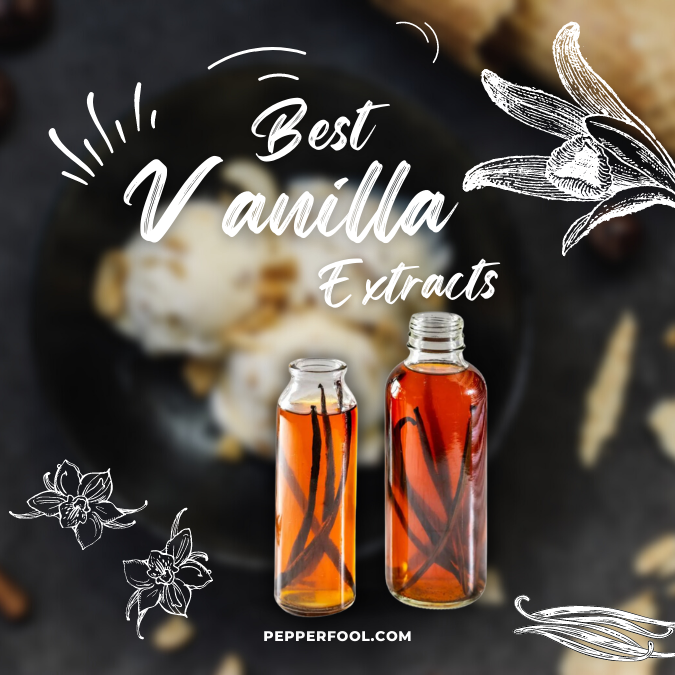
Best Pick
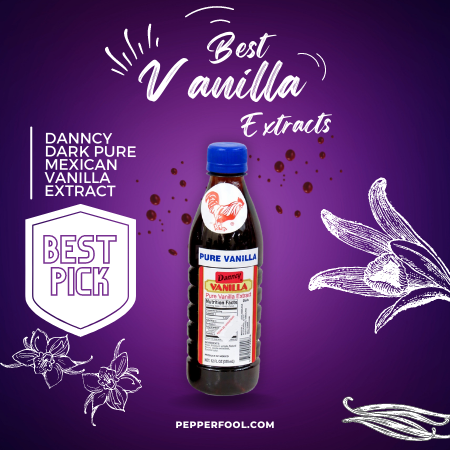
Perfectly striking that fine balance between quality and affordability, Danncy Dark Pure Mexican Vanilla Extract is made with pure Mexican vanilla and boasts all the bold, rich flavors that come from Mexican vanilla beans.
Budget Pick
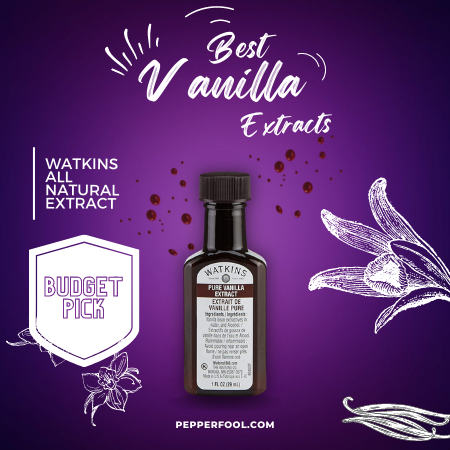
With an attractive price-tag compared to other varieties and a delicious classic Madagascan vanilla flavor profile, Watkins All Natural Extract is a good option if you want to cut back the costs without over-compromising on quality.
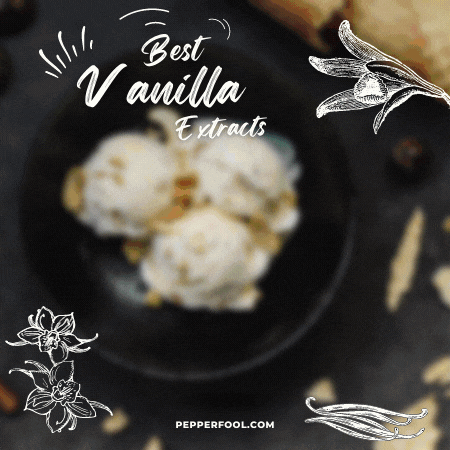
Quick Comparison: Top 10 Picks for Vanilla Extract
1. Danncy Dark Pure Mexican Vanilla Extract
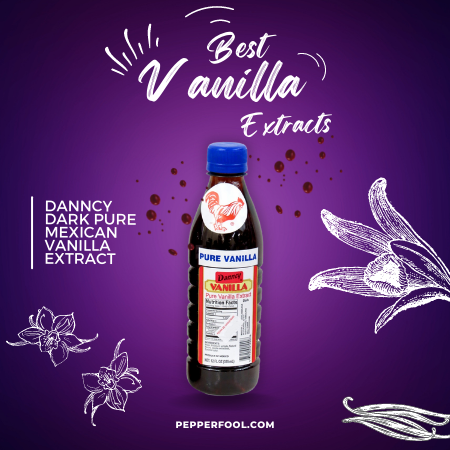
Danncy Dark Pure Mexican Vanilla Extract provides just what it says on the tin: pure vanilla extract with a dark, bold flavor.
Some buyers report that this extract is so much stronger than other types that you only need to use half as much, which is always a bonus.
Another bonus of this option is the cost. It isn’t the cheapest on our list, but it’s on the affordable side without compromising on flavor or quality.
There is also no need to be concerned about coumarin (a toxic substance sometimes found in ingenuine Mexican vanilla) with this extract, as it is made from authentic pure vanilla with no traces of coumarin.
Pros
Cons
2. Watkins All Natural Extract
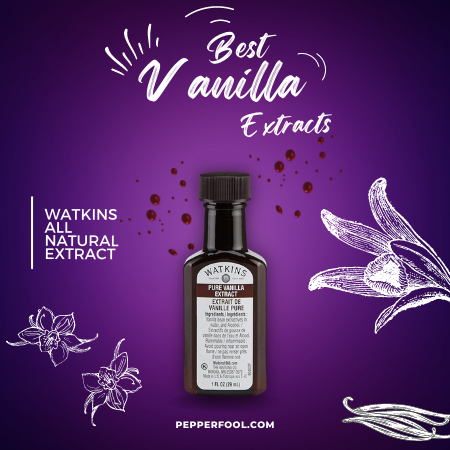
Looking for an affordable Bourbon vanilla extract that doesn’t drop the ball on quality?
Then Watkins All Natural Vanilla Extract could be a good option for you.
The Watkins brand has been around since 1868 and has a sturdy, long-lived reputation.
As we’d like to expect, their All Natural Vanilla Extract is made with quality ingredients, including 35% alcohol and pure vanilla beans.
You may also want to consider this option if you have certain dietary requirements or concerns, as it contains no artificial colors or flavors, gluten or corn syrup. It is also non-GMO and Kosher friendly.
However, some buyers have reported that it seems to have a slightly weaker vanilla flavor than other varieties. For this reason, you may need to use slightly more than expected if you want a strong vanilla flavor to come through.
Nevertheless, Watkins All Natural is our best budget pick and rivals the more expensive options on our list in terms of flavor and quality.Pros
Cons
3. McCormick All Natural Pure Vanilla Extract
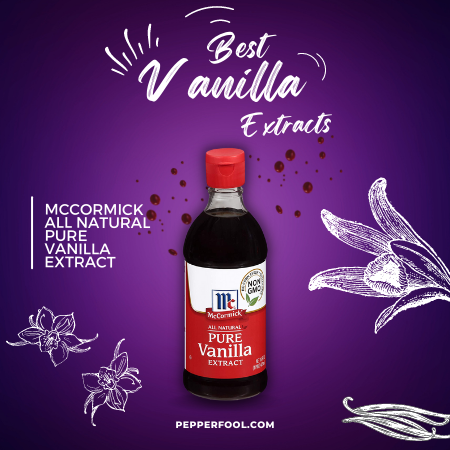
True to its name, McCormick All Natural Vanilla Extract is made only from high quality Madagascan vanilla beans, ethanol and water.
It contains no artificial colorings or flavorings and is non-GMO, gluten free and corn syrup free.
This extract is a firm favorite that provides that classic Madagascan vanilla flavor we know and love. McCormick describes the flavor as rich yet balanced with a hint of tasty, rummy bourbon.
You will get a more complex, nuanced flavor from more expensive options, but McCormick finds a good balance between quality and affordability.
Another great thing about McCormick All Natural is that its bottle comes with a handy easy pour spout, which is helpful for reducing mess or seepage.
Pros
Cons
4. Nielsen-Massey Madagascar Bourbon Pure Vanilla Extract
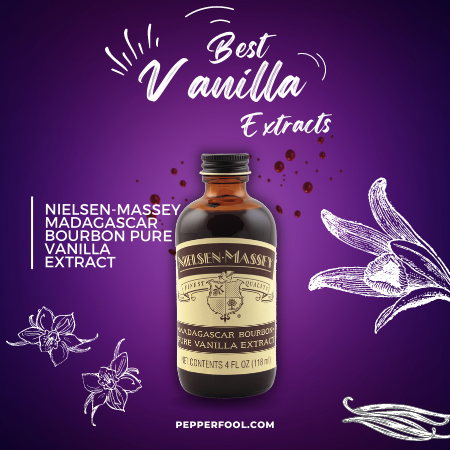
Nielsen-Massey Madagascar Vanilla Extract provides a premium flavor experience with high quality, hand-selected vanilla beans.
While there are less expensive extracts out there, this is one case where you get what you pay for.
The flavor profile of this extract is described as full, sweet, mellow and creamy.
It is sourced from Madagascan vanilla beans, so you can expect to achieve that classic vanilla flavor we’re most familiar with.
According to Nielsen-Massey, lower temperatures are used in the extraction process in order to ensure even the subtlest of flavors are preserved in the final product.
We also love the packaging and design of this extract. It comes in a lovely little bottle with a label that reflects the high quality of the extract it contains.
Finally, this extract is suitable for a variety of dietary needs. It is kosher, gluten free and suitable for vegans.
The one main potential drawback to note is that this option does contain added sugar. This isn’t such a bad thing in itself, but if you prefer your extracts to contain as few ingredients as possible, you may want to choose another option. The same goes if you’re health conscious or want to cut back on added sugar as much as possible.Pros
Cons
5. Usumacinta Mexican Vanilla Blend (Amber)
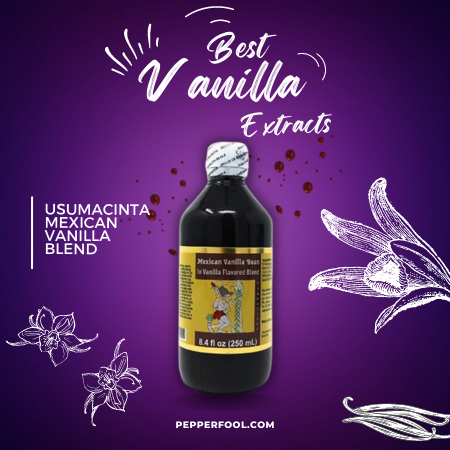
If you’re after the bold, robust flavor that you can only get from Mexican vanilla beans, this could be a good option for you.
Specifically, the flavor is described as rich and almost buttery and creamy with a strong, distinctive fragrance.
According to the manufacturer, this blend is created from high quality, carefully selected Mexican vanilla beans from the Sierra Madre mountain range.
However, as you may have noticed, its name classifies it as a “vanilla blend” rather than a “vanilla extract”.
This is an important distinction to make, because it means it may not contain enough alcohol or vanilla beans to qualify as an extract. Still, if you don’t mind not using certified vanilla extract, this could still be a good option for you.
Some buyers have questioned the authenticity of this product because there have been discrepancies in the ingredient list.Pros
Cons
6. Kirkland Signature Pure Vanilla Extract

Kirkland Signature Pure Vanilla Extract is a reputable yet affordable option that offers a classic Madagascan vanilla flavor.
Its flavor is described as rich and caramel-like with floral notes. While its flavor isn’t as complex or nuanced as other, it is affordable and provides a tasty flavor profile for the price.
This extract also has a beautifully rich, deep and dark color that is pleasing to the eye.
Though sugar is not always listed in the ingredients, some buyers report that it does contain added sugar, so you may want to be wary if you’re cutting back on the sugar.
Some buyers have also reported a potential change in formula, describing more recent batches as more watery than previous batches.
Pros
Cons
7. Rodelle Gourmet Pure Vanilla Extract
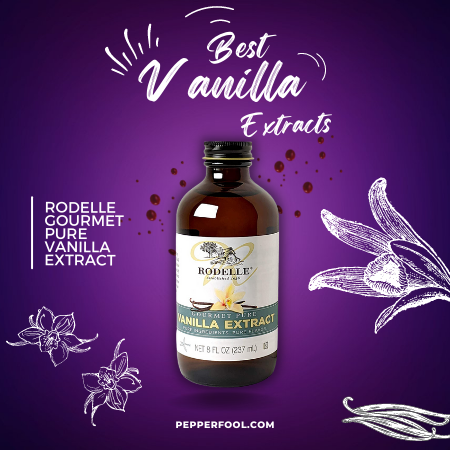
Rodelle Gourmet Extract is made from just three ingredients: vanilla extractives (from pure vanilla beans), alcohol and water.
It contains no added sugar, additives or preservatives, making it a great, affordable option if you just want pure vanilla extract and nothing else. Its flavor is described as uniquely rich and robust yet well balanced.
In order to promote sustainability and ethical sourcing, Rodelle is partnered with Sahanala – a cooperatives owned by employees that supports social programs and fair market values.
Rodelle also strive to be environmentally friendly in their production, producing their extract in a facility that is powered by the winds of Northern Colorado.
Pros
Cons
8. Heilala Pure Vanilla Flavor
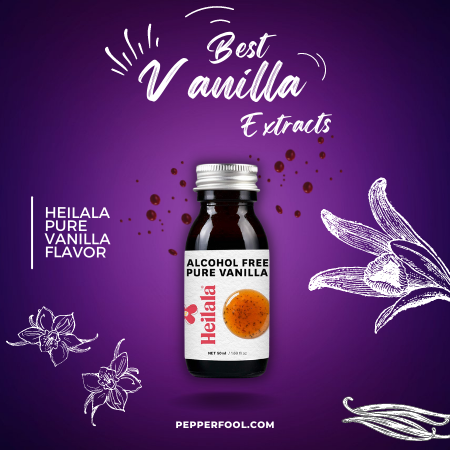
Okay, so Heilala Pure Vanilla Flavor can’t be classified as vanilla extract, but that’s because it contains no alcohol whatsoever.
This is great if you’re concerned about the high alcohol content of most vanilla extracts. Instead of alcohol, glycerin is used to extract the vanilla flavor from vanilla beans.
This Vanilla Flavor contains only glycerin infused with vanilla bean extractives, water and vanilla bean seeds – no artificial nasties.
Although you’d usually want to look for vanilla flavorings labelled “vanilla extract” rather than “flavor”, we’d make an exception for this one.
It contains all the delicious flavor of pure vanilla beans with none of the alcohol. The addition of vanilla bean seeds also adds a nice touch to the appearance, as they are usually visible even when cooked in a recipe.
Pros
Cons
9. Simply Organic Pure Vanilla Extract
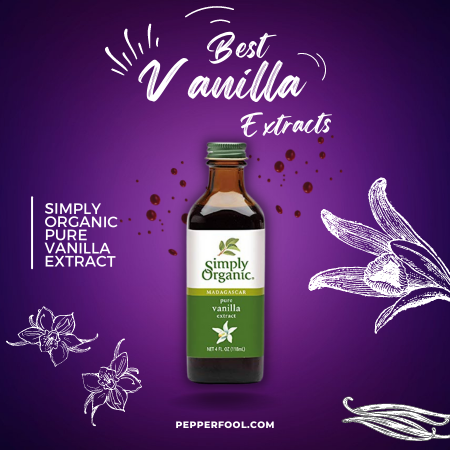
You won’t be surprised to hear that one of the selling points of this extract is the fact that it is organic and authentic.
Simply Organic pride themselves on the purity of their products, and this extract is no different, containing no GMOS, no artificial colors or flavorings and no added sugar. It contains only vanilla bean extractives, water and alcohol – pure and simple.
This extract has a pure yet potent Madagascan vanilla flavor. Its flavor profile is described is extra sweet with subtle floral notes and a delicious scent.
The color is also a deep, rich amber color which is as pleasing to the eye as the flavor to the taste buds.
Another great thing about this variety is that it comes from small scale farmer co-ops in Madagascar, supporting them and their businesses in an ethical and sustainable way.
Pros
Cons
10. Nielsen-Massey Tahitian Pure Vanilla Extract
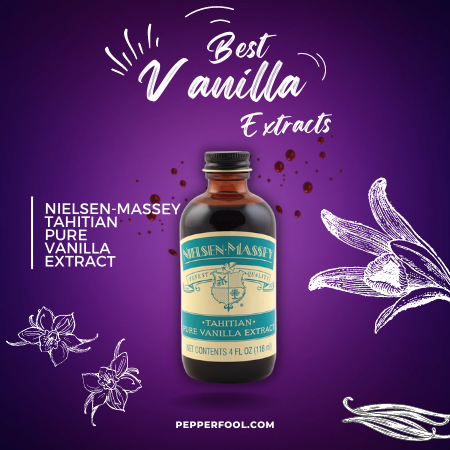
You may be experiencing a touch of déjà vu, as Nielsen-Massey vanilla extract was previously mentioned on this list.
So, what’s different about this variety? Nielsen-Massey’s Tahitian Pure Vanilla Extract maintains the same great quality of their Madagascan extract but is made from Tahitian vanilla.
Tahitian vanilla is known for its floral, fruity flavor and is often said to taste like cherries or anise.
Nielsen-Massey is high quality and created in a way that allows the full complexities of these flavors to come through, making it the perfect option if you want to experience the taste of Tahitian vanilla in all its glory.
Like their Madagascan vanilla extract, this Tahitian variety is suitable for a variety of dietary needs. It is kosher, gluten free and suitable for vegans. There are just a couple of drawbacks to note here.
The first is that this extract is not free of added sugar, so if you’re trying to cut back, you may want to go with another option.
The second is that Nielsen-Massey extracts are generally on the expensive side. However, this is not because it is overpriced but because of its excellent quality – you get what you pay for!Pros
Cons
Things to Consider when Buying Vanilla Extract
Still confused about which vanilla extract would be best for your needs? This section will go over all you need to know about vanilla extract and the considerations you should make before making your final decision.
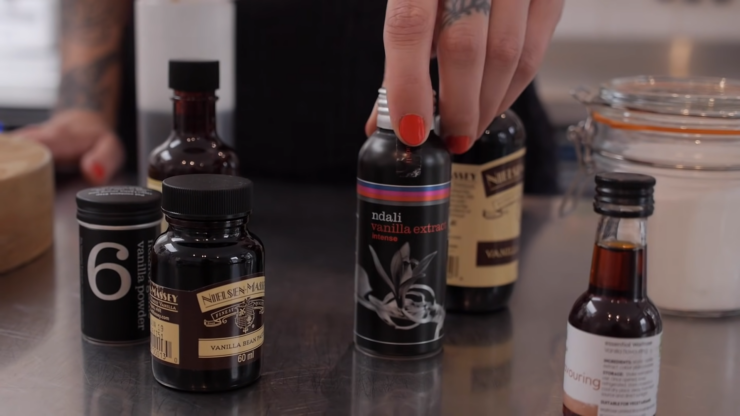
Source: youtube.com
To most of us, vanilla extract is simply a popular ingredient that are dessert recipes simply wouldn’t be the same without. But what is it actually made of? And what processes does it go through before it ends up as the tasty solution we know and love?
To get to the bottom of these questions, we have to start all the way back in the vanilla farms of Madagascar, Mexico or Tahiti. These are the three main regions where vanilla is grown, and a huge 80% of that comes from Madagascar.
Vanilla is a highly sensitive crop that requires months of tender love and care and can only be grown in very specific conditions, hence why its origin countries are so limited.
Once the vanilla is finally harvested, much of it used to make vanilla extract. But before it can be turned into liquid form, vanilla beans must be “cured”.
This means they must be “blanched” (quickly soaked in hot water) to stop the bean from ripening and stimulate an enzyme that helps develop that distinctive vanilla flavor we know and love.
Next, the beans are rolled up in blankets, stored in airtight containers and kept in the dark, which allows them to “sweat” (a type of fermentation).
The blankets used to hold the vanilla beans must be unrolled and exposed to the sun and rerolled every day for 1-2 months, which clearly significantly adds to the labor-intensity of the process. The beans are then left to airdry for up to a month.
The final step before the next stage begins is called “conditioning”, which is done by wrapping the now dry vanilla beans in wax paper and storing them in an airtight box for about a month.
…And that’s all before the manufacturing of vanilla extract actually begins! As you can see, growing, harvesting and curing vanilla beans is quite the lengthy ordeal, taking over a year in total.
In order to be turned into extract, the vanilla beans are macerated and percolated (fancy words for softened, broken up and filtered) in a mix of water and ethanol. The mix of ethanol and water pulls the many flavor compounds from the vanilla to extract the essence of its flavor.
Performing this process at higher temperatures will speed up the process but lessen the complexity of the flavors and therefore lead to a lower quality result.
Conversely, when lower temperatures are used, the process takes longer but captures all the subtleties of vanilla’s flavor profile and creates a higher quality extract.
Why is vanilla extract so expensive? And why does its price fluctuate so much?
As much as we love our vanilla, we’re not so keen on the price-tag that comes with it. And why is it that the price of vanilla can seem reasonable enough one week and significantly higher the next?
Let’s start with its expensiveness. Hopefully after reading our summary of how vanilla extract is made, you’ll have gained an appreciation for why it is so unavoidably expensive.
It takes over a year for vanilla beans to get to the point where they are even ready to be turned into extract.
And we’re not just talking about time here, but incredible amounts of energy and labor. From the hand pollinating to the daily unrolling and rerolling of the ripened vanilla beans, every step of the process comes with its unique challenges and labor needs that really ramps up the overall cost.
Okay – makes sense, but if the process of making vanilla extract is fairly set in stone, then why does the price vary so much from week to week or month to month?
Once you remember that a huge 80% of the global supply of vanilla comes from the relatively small island of Madagascar, the answer becomes a little clearer.
A single significant event in Madagascar such as a storm or hurricane can wipe out a huge portion of this supply, which sometimes leads to a drastic increase in price for us consumers. Less available vanilla beans means less vanilla extract produced and higher competition among shoppers.
There are also several other factors that can contribute to these fluctuations. For example, in 2004, after the effects of tropical cyclones along with political upset and poor weather conditions in Madagascar, the price of vanilla extract shot up to a staggering $500 per kilo.
Similar spikes have been caused by several other cyclones and poor weather conditions.
Luckily, though, the price of vanilla extract is fairly stable most of the time, and you can always stock up if you’re worried about having to pay more under such circumstances.
The History of Vanilla Extract
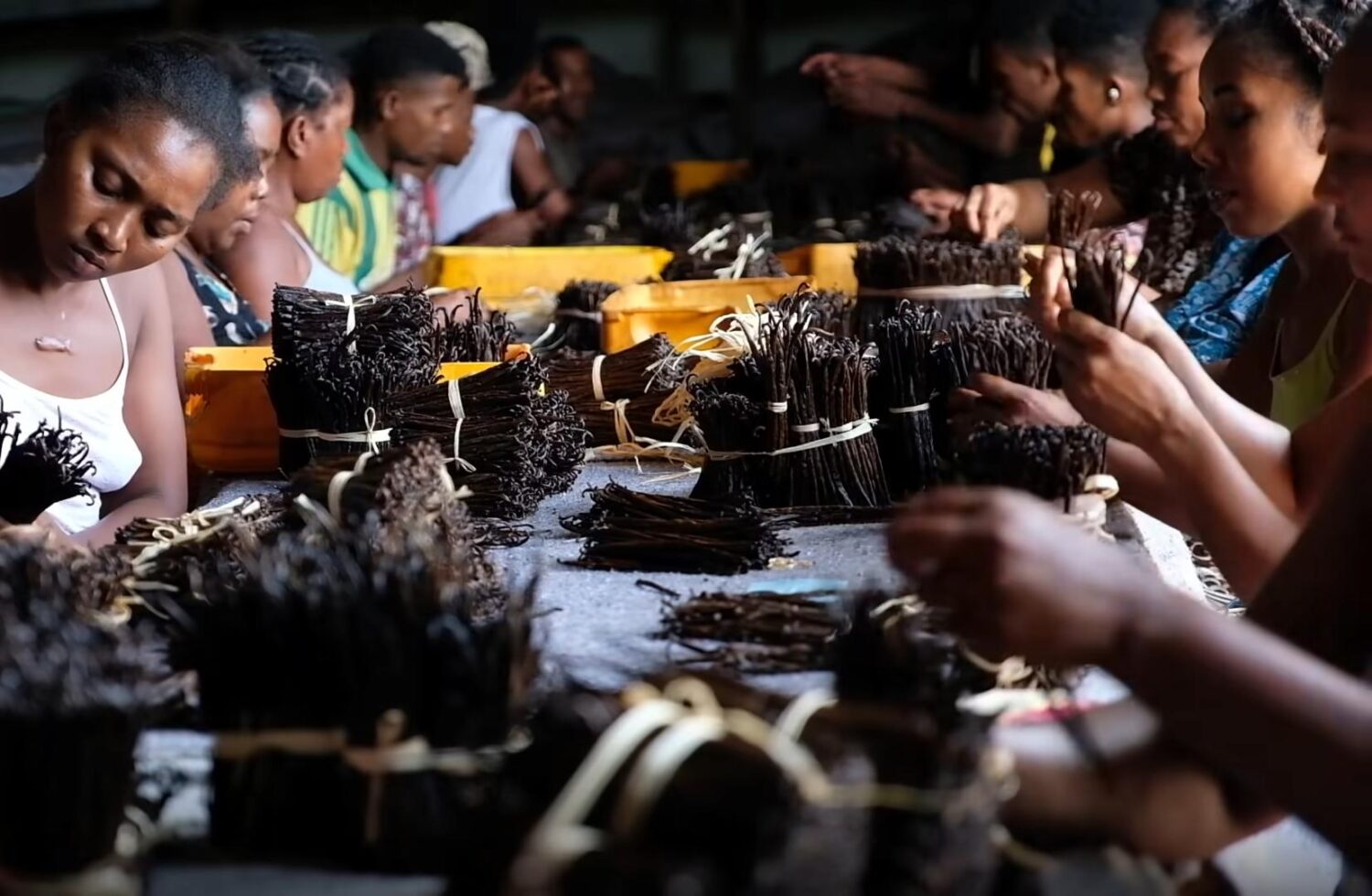
While you don’t need to be a vanilla historian in order to know which type or brand of vanilla is best for you, it’s interesting to know all the same.
You may be surprised to hear that despite Madagascar’s modern domination of the vanilla market, it was actually Mexico that was the world’s number one supplier back in the 1500s.
Mexico’s monopoly on all things vanilla continued all the way through to the late 19th century, until Madagascar slowly but surely began to approach the market domination we see today.
But when did vanilla extract specifically first grace our taste buds? Its origin dates all the way back to 1847, when it was first sold commercially by Joseph Burnett.
Is Vanilla Extract Vegan?
You may be confused on this one, as many online resources seem to have conflicting information. However, you’ll be happy to know that the short answer to this question is yes, real vanilla extract is vegan.
The reason for much of the confusion caused around this topic is actually because of imitation vanilla, not real vanilla extract.
In the past, and less commonly today, certain varieties of imitation vanilla contained castoreum, which comes from beavers’ anal glands (lovely, we know). It is rare even for imitation vanillas to contain this substance these days, but it is extremely rare that you’d have anything to worry about with the real stuff.
Real vanilla extract is comprised of just vanilla bean extractives, alcohol and water, all of which are vegan. Sugar is sometimes added into the mix too, which is also plant-based.
If you want to be extra careful, you can always check the list of ingredients before you buy to ensure there aren’t any nasty surprises.
Too Much Alcohol?
You may have noticed that we said vanilla extract must contain at least 35% alcohol in order to be considered real vanilla extract. That might sound like quite a lot of alcohol to you, because, well, it is.
Of course, when we’re baking, we only use a tiny amount of vanilla extract at a time. Because most recipes will typically call for just a teaspoon or two, you’ll never really be using enough to feel the effects of its alcohol content.
However, if you’re striving to be 100% teetotal or have religious or health reasons for avoiding alcohol completely, you may want to consider vanilla flavoring that contains no alcohol.
This may seem a difficult challenge initially, as vanilla extract must contain a high alcohol percentage to be classed as vanilla extract.
But not to worry – there are plenty of high quality vanilla flavorings, powders and pastes that contain high concentrations of pure vanilla beans with none of the alcohol.
Pure Vanilla vs. Artificial Vanilla
Not all vanilla flavorings are created equally. When you’re in the market for authentic vanilla extract, it is important to note the different between real vanilla extract and artificial vanilla flavoring.
Look for bottles labelled with “pure vanilla” or “pure vanilla extract” rather than “vanilla flavoring” or “vanilla essence”.
Vanilla extract has a high concentration of both ethanol and vanilla beans. Vanilla essence or vanilla flavoring cannot legally be called vanilla extract because they do not contain the amounts of vanilla or alcohol required to be labelled as such.
Alcohol and Vanilla Bean Content
So what sort of ethanol percentage should you be looking for in your vanilla extract? The regulations and guidelines vary by country, but according to the USFDA, vanilla extract should contain no less than 35% alcohol.
As for vanilla bean content, the USFDA states that vanilla extract should contain around 100 grams of vanilla beans per liter. If you want to be sure that your vanilla extract is authentic, it may be a good idea to check the label for its ingredients and alcohol and vanilla bean content.
Price Point & Authenticity
Authentic vanilla extract never comes cheap. Vanilla extract is costly, time consuming to produce and vanilla can only be grown in certain areas of the world.
For these reasons, you should be wary of vanilla extract that is significantly cheaper than the average price.
If you don’t want to break the bank, there are more affordable options that don’t over-compromise on quality (such as Watkins All Natural Extract). As long as you go with reputable brands and sellers, you should have nothing to worry about.
This is especially important with Mexican vanilla extract, as it may contain a toxic substance called coumarin if it is significantly cheaper than expected.
Vanilla Extract Types – Bourbon (Madagascan), Mexican and Tahitian
Did you know that vanilla extracts created in different areas of the world have noticeably different flavors?
Bourbon (or Madagascan) vanilla extract is the most common variety and provides the classic vanilla flavor most of us are accustomed to. It has a pure, clear flavor with floral overtones.
Tahitian vanilla extract contains less vanillin than Madagascan and Mexican vanilla extract, but it also has a more varied flavor. It is subtle, fruity and sweet, with flavors that can be defined as caramel and cherry-like.
Mexican vanilla extract has a darker color and a stronger, more robust flavor than Madagascan and Tahitian vanilla extract.
There is no clear winner out of these three types. Which you opt for all depends on your own tastes and the dishes you’re planning to use it in.
However, if you want to be on the safe side, sticking to the classic Bourbon (Madagascan) vanilla extract is always a good option.
Go for coumarin-free Mexican vanilla
When looking at Mexican vanilla extracts, it is important to ensure that it is free from coumarin. Coumarin is a toxic substance that was once commonly found in Mexican vanilla extracts. It is also banned in the USA.
Thankfully its use has decreased since coming to the attention of the public, but it remains an important thing to look out for.
Check also these vanilla extracts that are available on Amazon:
